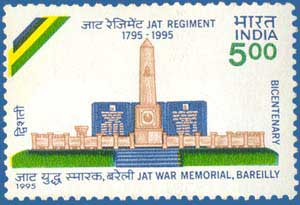
JAT REGIMENT

The history of the Jat Regiment dates back 1795 when a garrison unit "the Calcutta Native Militia" was raised at the presidency for local guard duties. Converted into a regular infantry unit in 1861 it was finally amalgamated with the Jat Regimental Centre in 1923. Three other units joined the regiment in 1923. By the end of the Second World War, the number of battalions had increased to five. After independence the regiment underwent periodic expansion, and today has 19 battalions including one Territorial Army unit.
During its 200 year long history the regiment has served with great distinction within and outside the country and has earned 34 battle honours and large number of gallantry awards including one Victoria Cross, three George crosses, seven Mahavir Chakras, five Kirti Chakras, thirty four Vir Chakras and ten Saurya Chakras. Its first Battalion, now a mechanized infantry Battalion, was the only unit in the British Indian Army to have been awarded the twin honorifs of "Royal" and "Light Infantry". The 3rd Battalion, the fourth highest decorated unit of the British Indian Army during the Second World War, received universal acclaim for its outstanding action at Dograi in 1965, now considered a landmark battle by military thinkers.
The Regiment has also contributed in contigents to U.N. forces in Korea in 1953-54 and later in Congo in 1961-62. The regimentís motto "Sangathan Wa Veerta" underlines the eternal relevance of valour and espirit-de corps in a soldierís life.
Date of Issue: 20.11.1998